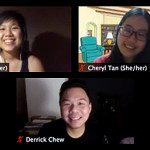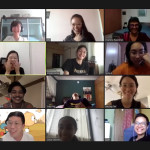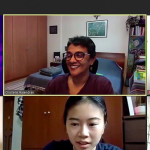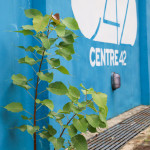Last month, Centre 42 presented our online workshop Performance Arts and Augmented Reality, facilitated by Tan Shou Chen, a freelance theatremaker, and Timothi Lim (“Tim”), Creative Director of Augmented Reality at The Doodle People. Here are four key takeaways from the three-part workshop:
1. Staying technology positive
Adopt an open mindset in discussions about technology – Shou Chen encouraged the class to be “technology positive”, acknowledging that technology has always been ubiquitous and empowering to humankind. Even in the arts, he said, the use of video, lighting and sound technology is not a foreign concept.
“We are already using technology to perform identity and even augment our own realities,” he said, referring to the wide-spread use of applications, such as Instagram, Snapchat, Tiktok, and their filter functions which employ the use of augmented reality.
The 17 performance-makers and production designers were introduced to photogrammetry, a technology which creates photorealistic three-dimensional assets from two-dimensional photos. The participants tried out photogrammetry with the mobile app Qlone.
Tim also demonstrated volumetric video capture, which can record and/or track the movement of 3D live objects. The technology can also be used to add virtual effects which distort or enhance the live physical body live.
2. Manipulating body, space and time
These technologies convert physical reality into digital data. Tim explained that this data can then be manipulated to shape our perception of body, space and time, creating dynamic and meaningful options for performance. Virtual bodies and spaces can transcend limitations of form and size, or even completely reimagines. Linear time, too, can be played with.
The manipulation of data can inspire possibilities of how augmented reality (AR), virtual reality (VR) and mixed reality (MR) can be used in performance. AR introduces the virtual world using screens and devices as a portal to enhance the real world. Since it essentially overlays a virtual design upon the real world, AR can manipulate perspectives while maintaining a keen sense of the physical reality for the user. VR, on the other end of the spectrum, immerses the user and their physical movements into a purely digital environment. Lastly, MR can create an experience that brings the virtual design into our physical world.
“If we think about how we are manipulating data, rather than trading away reality, technology becomes a tool to further the aura of the live performer,” regarded Shou Chen. “We can even think about how technology itself has aura.”
With all these potentialities these technologies can create, artists can reimagine what it means to engage with technology and technologists in creative projects.
3. Weighing the cost of adoption
Some participants shared concerns about the prohibitively high costs of these relatively new technologies. Tim explained that new technological products always start out expensive due to few users; the price tends to come down with more widespread adoption. Photogrammetry and volumetric video capture technologies are still expensive, but they have been growing much more accessible in recent years – Qlone as one of several free photogrammetry mobile app, and Microsoft’s Kinect camera for volumetric video tracking, are examples.
4. The dramaturgy of technology
The facilitators emphasised that the decision to use these technologies in performance-making should be guided by a clear artistic vision. Technology ought not be a mere accessory to the performance, but should be purposefully incorporated into the design and dramaturgy of the experience.
One way to ensure this is to work with a creative technologist early and closely.
“Creative technologists are not working for artists,” Tim reminded the participants. “We’re working with you.”
By Lee Shu Yu
Published on 31 Aug 2020
Performance Arts and Augmented Reality was an online workshop facilitated by Tan Shou Chen and Timothi Lim (The Doodle People). Held on 28 Jul, 30 Jul and 4 Aug 2020, 17 performance-makers and production designers were exposed to the potentialities of photogrammetry and volumetric video capture technologies in performance. The workshop was developed by The Doodle People and commissioned by the National Arts Council Singapore. For more information, click here.






